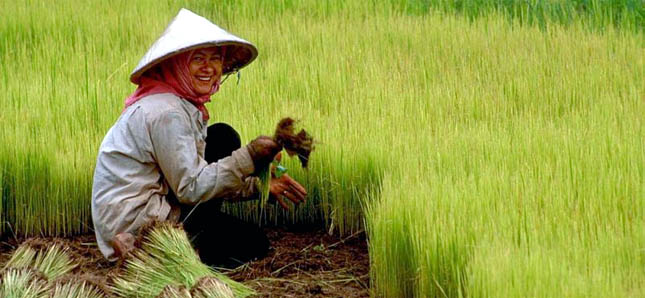Asia’s Regional Economics: A Bowl of Rice a Day

Aug. 13 – At a time when China’s economy seems to be slowing, and costs rising, we take a look at one of the forgotten aspects of Asian economics, the cost of a bowl of rice.
In a region comprising the giant populations of China (1.3 billion), India (1.25 billion) and the emerging nations of Southeast Asia (collectively, about 880 million), much of the economic data on China trends misses two points; the massive impact on China that emerging Asia has; and the financial impact of the poverty level rising by just one more affordable bowl of rice a day, per person.
In the scramble to unravel China’s economics, and the questions inflation and a slowing GDP ask, much has been made of a potential recession in the U.S. markets and the competitive impact of a resurgent India. While the recession has made an impact, the rise in wealth of China’s neighboring countries also has had a major impact on the region, and on China. India’s population is set to shortly (if it hasn’t already) overtake China’s ageing one, while the combined populations of Indonesia, Pakistan, Bangladesh, the Philippines, Vietnam, Thailand, Myanmar, Malaysia, Cambodia and Laos are close to three quarters of both China and India individually.
In the rush to understand China economics, the populations of smaller countries, such as Vietnam (85 million) have been forgotten. Yet collectively, the third part of the Asian triangle is nearly as large as the other two.
Such oversights are misleading. Emerging Asia has a huge impact on what goes on in China and how it affects prices. While growth regionally in countries such as Cambodia and Laos—relative minnows with populations of 14 and 7 million each—would not seem to have any clout or impact on the China price, when included with the other regional markets—all growing from between 7-10 percent annually—the implications seem to become more serious. Just raising the level of wealth in these countries enough to allow each person an additional bowl of rice a day would have a profound impact.
It’s been happening. While rice consumption in China has fallen by 860,000 tons annually over the past three years (the only Asian nation in which this has occurred), it has been far outstripped by an increase in consumption in India of 6,522,000 tons. Consumption in the additional emerging Asian economies we mention above collectively rose by a further 6,419,000 tons, almost equivalent to that of India’s rise. That’s an increase of over 12 million tons since 2005. Considering that in terms of global productivity for rice per acre, that means a rough estimate of an extra 8 million acres has had to be set aside during that same period just to meet that demand – and from a region whose arable land mass is far from efficient.
The cost impact has been huge, and is also difficult to track down. With such a stress on domestic suppliers, governments have been subsidizing the true cost of production by giving farmers handouts, and by literally digging into reserves. Cyclones earlier this year in Southeast India destroyed crops, forcing the government to step in to write off debt and keep families alive. Rice reserves held in stock are dropping, and much has been found to have been poorly warehoused. Meanwhile, prices in Pakistan have increased by US$200 per ton or about 30 percent in the past 28 months and prices have risen by similar amounts in Thailand and Vietnam.
The implications for China’s decrease in consumption should not be taken lightly either; the jury is still out as to whether this is truly a sign of increased efficiencies in China’s farming, or a more worrying switch to higher value, and more expensive to produce cereals as the population wealth increases. This anomaly may also not be what it appears. China remains a net importer of rice, and has recently signed agreements with both Pakistan and Japan to import additional quantities due to an expected upsurge in domestic consumption. The costs of supplying China, and the rest of Asia, with rice—fuel costs, more use of land, irrigation and so on—continues to rise.
China and emerging Asia’s continued growth and development is raising several questions: who has really factored in the micro-elements impacting the economies; what is truly the impact of an additional bowl of rice, per day, per head of regional population; and what are the costs and impacts upon the regional economies, including that of China, to deliver just such a basic staple.
Emerging Asia may be booming, but much of the commodity price impact, as the region places more demands on resources will surely affect China’s own provision of its basic resources as well as the China costs in doing so.
- Previous Article China’s Retail Sales Increase 23% in July
- Next Article Drying Up: China’s Looming Water Crises









